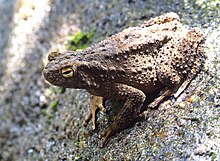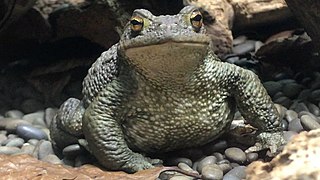
The common toad, European toad, or in Anglophone parts of Europe, simply the toad, is a frog found throughout most of Europe, in the western part of North Asia, and in a small portion of Northwest Africa. It is one of a group of closely related animals that are descended from a common ancestral line of toads and which form a species complex. The toad is an inconspicuous animal as it usually lies hidden during the day. It becomes active at dusk and spends the night hunting for the invertebrates on which it feeds. It moves with a slow, ungainly walk or short jumps, and has greyish-brown skin covered with wart-like lumps.

The American toad is a common species of toad found throughout Canada and the eastern United States. It is divided into three subspecies: the eastern American toad, the dwarf American toad and the rare Hudson Bay toad. Recent taxonomic treatments place this species in the genus Anaxyrus instead of Bufo.

The southern toad is a true toad native to the southeastern United States, from eastern Louisiana and southeastern Virginia south to Florida. It often lives in areas with sandy soils. It is nocturnal and spends the day in a burrow. Its coloring is usually brown but can be red, gray, or black. It is approximately 8 cm (3 inches) long.
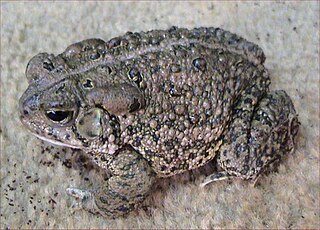
Woodhouse's toad is a medium-sized true toad native to the United States and Mexico. There are three recognized subspecies. A. woodhousii tends to hybridize with Anaxyrus americanus where their ranges overlap.

The North American green toad, formerly in the genus Bufo, is a species of toad found in the southwestern United States in the states of Arizona, New Mexico, Colorado, Kansas, Oklahoma and Texas, as well as in northern Mexico in the states of Tamaulipas, San Luis Potosí, Durango, and Zacatecas. It is commonly called green toad.

The Great Plains toad is a relatively large species of true toad native to central North America.

Megophrys montana is a species of frog found in Java and possibly Sumatra.

The Asiatic toad or Chusan Island toad is a species of toad endemic to East Asia. The species was previously classified as Bufo bufo gargarizans, a subspecies of the common toad.

Barbarophryne is a genus of toads in the family Bufonidae. It is monotypic, containing only the species Brongersma's toad, also known as Tiznit toad. It is found in Algeria, Morocco, and Western Sahara. It is a small toad, up to about 5 cm (2 in) in snout–to–vent length.

Phrynoidis juxtasper, also known as the giant river toad or Borneo river toad, is a species of toad in the family Bufonidae. It is found in Borneo and Sumatra (Indonesia) below 1,600 m (5,200 ft) asl. Prior to its species description, it was confused with Phrynoidis asper.

The African bullfrog is a species of frog in the family Pyxicephalidae. It is also known as the pixie frog due to its scientific name. It is found in Angola, Botswana, Kenya, Malawi, Mozambique, Namibia, South Africa, Tanzania, Uganda, Zambia, Zimbabwe, and possibly the Democratic Republic of the Congo. It has been extirpated from Eswatini. It has long been confused with the edible bullfrog and species boundaries between them, including exact range limits, are not fully understood. Additionally, P. angusticeps of coastal East Africa only was revalidated as a separate species in 2013.
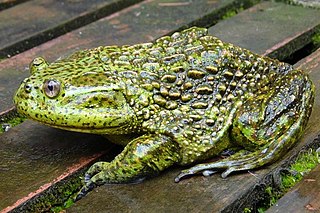
Calyptocephalella is a genus of frogs in the family Calyptocephalellidae. It is represented by a single living species, Calyptocephalella gayi, commonly known as the helmeted water toad, Chilean helmeted bull frog or wide-mouth toad. Additionally, there are a few extinct species that only are known from Late Cretaceous and Paleogene fossil remains from Patagonia in South America and in the Antarctic Peninsula. The helmeted water toad living today is aquatic to semi-aquatic, and found in deep ponds and reservoirs in central Chile and possibly adjacent west-central Argentina.

Phrynoidis is a small genus of true toads, family Bufonidae. They are found in Mainland Southeast Asia and the Greater Sundas. They are sometimes known as the rough toads or river toads.
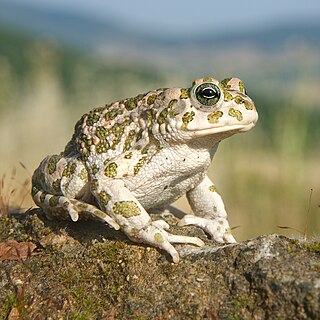
Bufotes, the Eurasian green toads or Palearctic green toads, is a genus of true toads. They are native to Europe, western and central Asia and northern Africa; a region roughly equalling the western and central Palearctic. Historically they were included in the genus Bufo and then for a few years placed in Pseudepidalea, which is a synonym of the currently accepted name Bufotes.
